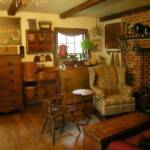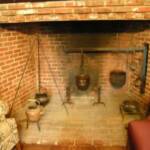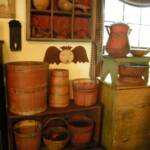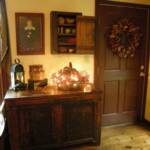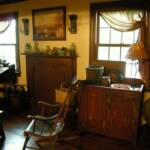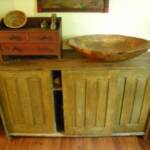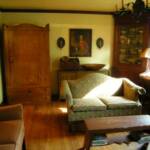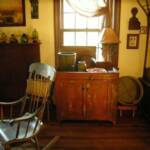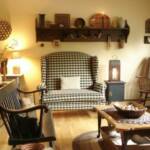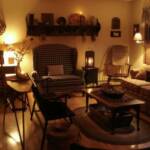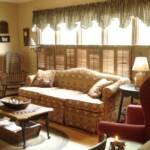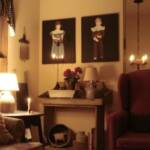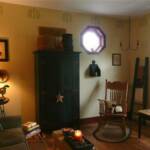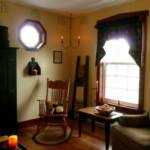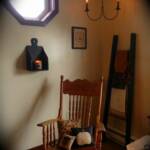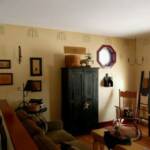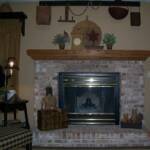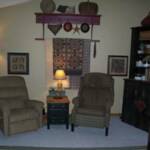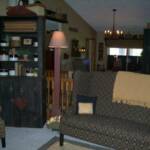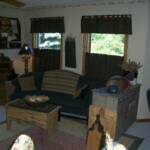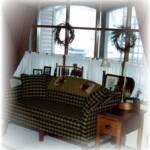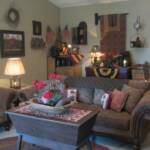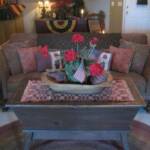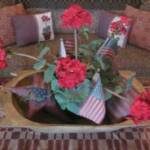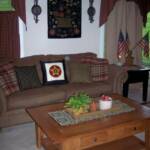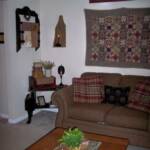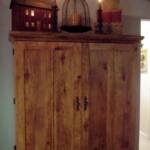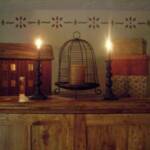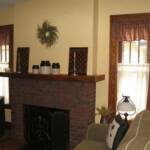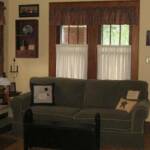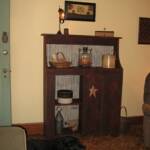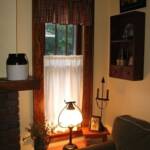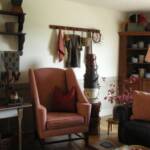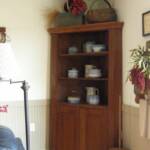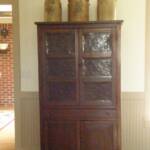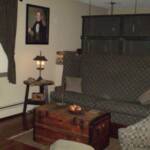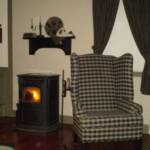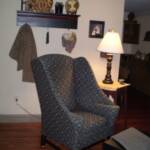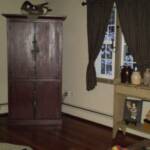A Primitive Place
www.aprimitiveplace.org
Email: info@aprimitiveplace.org
Primitive & Colonial Inspired Homes
THE KEEPING ROOM
What is a Keeping Room?
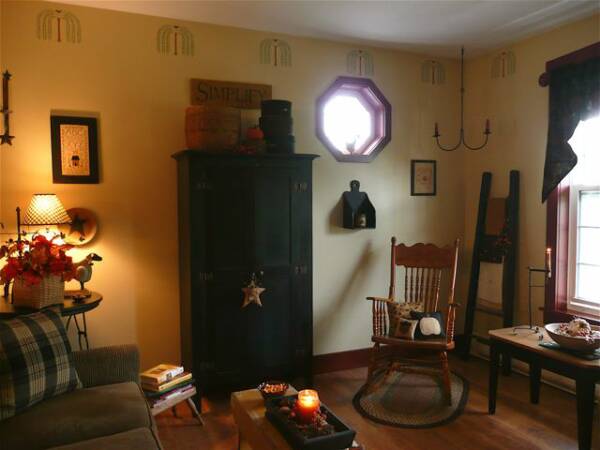
Photo submitted by HomeOnTheHill 2008
During colonial America,windows were covered with heavier linens in the winter to help with insulation. In the summer, those heavier textiles were taken down and lighter linens replaced the winter ones. Shutters indoors and outdoors were used. Indoor shutters often disappeared into casing and were pulled out to shutter drafts out.
What you'll find in a primitive/colonial home:
1) Samplers–the way young girls learned their stitches and their alphabet. Samplers contain: different stitches used as a reference if she forgot how to mend something; a verse reminding her of a virtue she should abide by; genealogical data of her family; a date and possibly her name or initials.
2) Hook rugs–also made by women for their family. Women had very hard, short lives in colonial America. Their homes were carved from the wild beauty that surrounded them. Taking plain wool and dying it, then hooking it not just into geometric shapes, but a picture brought a little beauty into a rugged cabin.
3) Pottery– used in the kitchen to store or bake; their simplicity and durability make them a favorite old or new. The simple potter’s marks in cobalt blue added a little color to the kitchens of old.
4) Pewter–once called the poor man’s silver adds a touch of formality without being too “gentry”.
5) Treenware–wooden pieces for the kitchen; bowls, utinsels, boards
6) Quilts, Coverlets - the work that went into making the everyday items for families makes us grateful once again that we can enjoy the artifacts, without worrying if we have enough made to keep everyone warm in the family.
Decorating tip: A good rule of thumb: Use 3 to 4 colors only in a room. Two of which should travel to other rooms. One or two can be your accent colors. Designate one color as the dominant color and another one for the secondary color.
Rustic furniture, no clutter, plain unadorned walls and natural earthy colors are features seen in the American Colonial Style home. The simplicity of it all creates a light and airy interior with simple clean lines.
This page was last updated: March 8, 2010
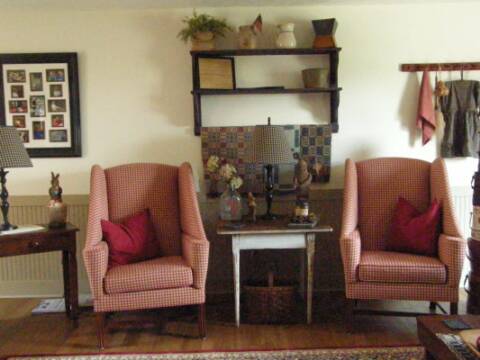
Submitted by primchick 2009
Submitted by primlover63 2009
Submitted by Behind My Red Door 2009
Click on thumbnail to enlarge photo
Submitted by Behind My Red Door 2009
Submitted by Winterberry Farm 2009
Submitted by Winterberry Farm 2009
In colonial days, original fabrics and hand painted furniture inspired the interior colors, as walls were kept a light color. Colors used in fabrics and furniture were earthy tones, greens, browns, black, subtle blues and cool whites.
Decorating tips: Add natural elements to your displays to add color & texture (fill baskets and pottery with dried or fresh flowers)
Vary the heights of items for visual appeal (add wooden boxes, or small stools or benches to lift things up)
Make more of an impact by grouping like items together.
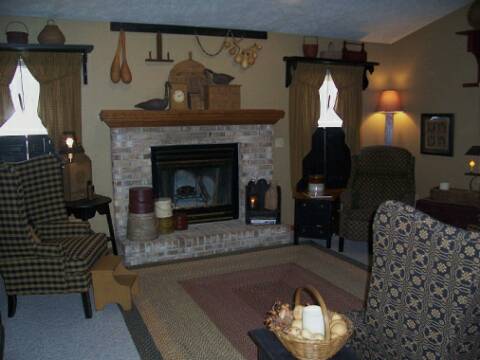
Submitted by A Primitive Pond Homestead 2009
Click on thumbnail to enlarge photo
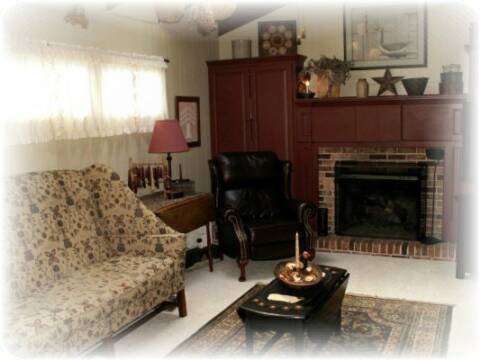
Submitted by KM Primitives 2009
Click on thumbnail to enlarge photo
Since the area could be heated by the kitchen stove, it often provided the only heated place in the house.
In Colonial times, children played there and families gathered there to read, talk, play games and often keep warm by the fire.
Today, a keeping room is called a family room, a great room and a hearth room.
Keeping Room Staples
Keeping rooms and kitchens had a wide range of essential furnishings that were as hardworking as the people who used them. Ruggedly handcrafted, special-use-pieces such as pie safes, jelly cupboards, dry sinks and sugar chests served early homemakers with primitive convenience. Today, these pieces add vintage appeal to almost any room of the house.
Photo left: Dry sinks, low cupboards usually topped by zinc-lined wells, held buckets and basins of water for household chores. They were typically made of pine, an abundant wood source that cabinetmakers found especially easy to craft. Behind the cupboard door, there was storage or, often, a pail to catch drainage from a hole in the well.
Submitted by Winterberry Farm 2009
Click on thumbnail to enlarge photo
Photo left: A fireplace is the focal point in many keeping rooms today.
Click on thumbnails to enlarge photo
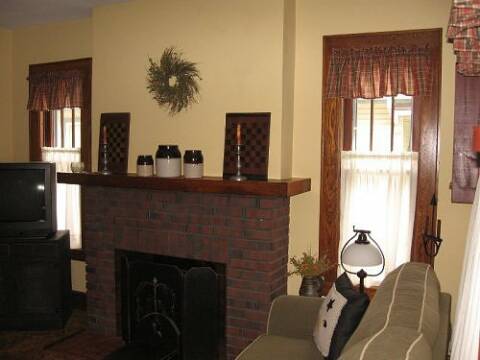
Submitted by primkarlee 2009
Click on thumbnails to enlarge photo
Submitted by The Patriot Homeplace 2009
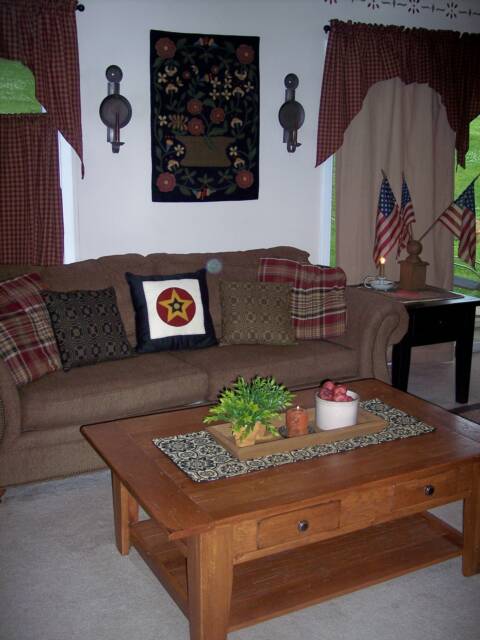
Submitted by CozyCoop 2009
Click on thumbnail to enlarge image
Click on thumbnail to enlarge image
A keeping room is an area just off the kitchen of a home. Keeping rooms date back to Colonial times when families would sleep in that area when the rest of the house was cold.
Photo right:
This stunning living room from KM Primitives was just featured in Country Sampler.
Photo left: Crocks and gameboards adorn Karen's fireplace.
Click on thumbnails to enlarge photo
